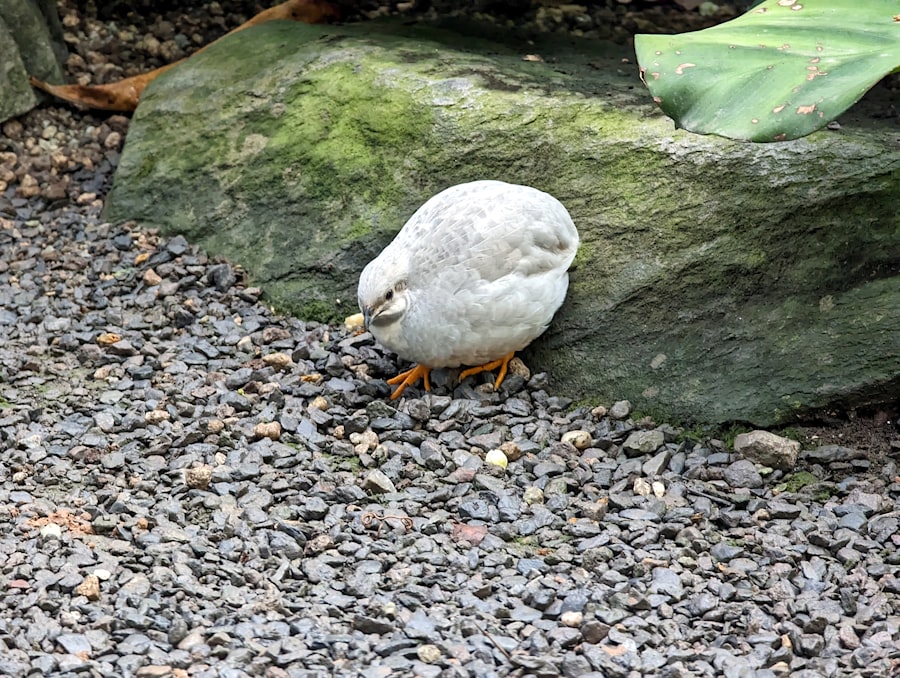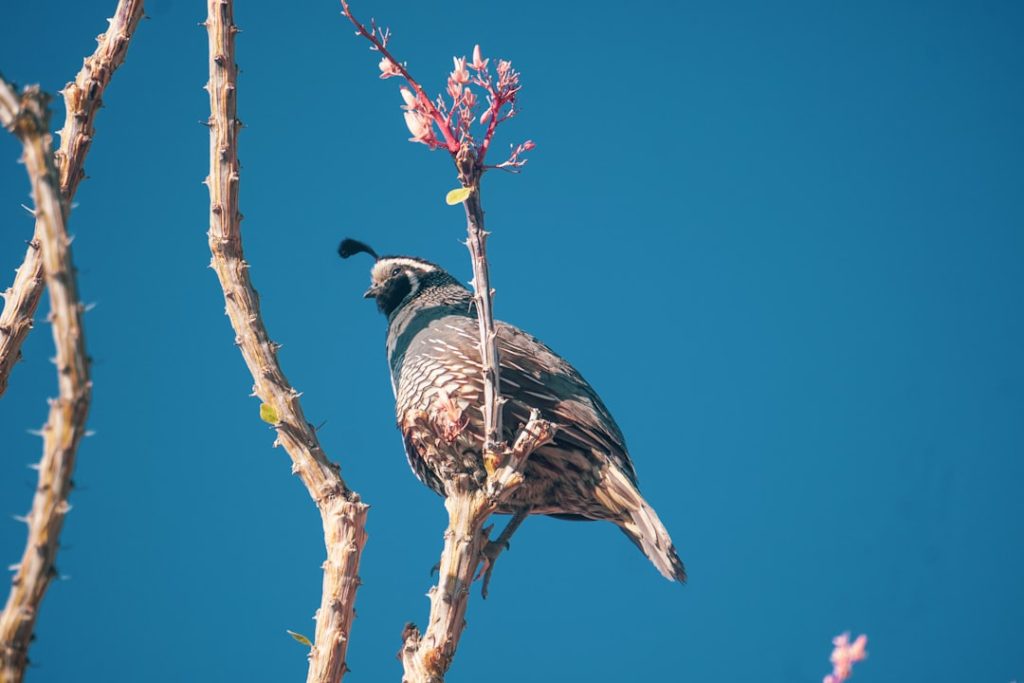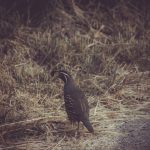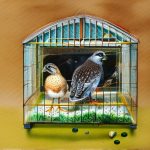Gambel’s quail, also known as desert quail, is a species of New World quail found in the southwestern United States and parts of Mexico. Named after naturalist William Gambel, this bird is known for its distinctive appearance and interesting behaviors. Gambel’s quail are highly social birds that are often found in coveys, which are small groups of birds that forage and roost together. They are ground-dwelling birds that prefer to run rather than fly, but when they do take flight, their short, rapid wingbeats and distinctive call make them easily recognizable.
Gambel’s quail are popular game birds and are often hunted for sport and food. They are also a common sight in arid and semi-arid habitats, where they can be found foraging for seeds, insects, and vegetation. These birds are known for their striking appearance, with a distinctive teardrop-shaped plume on their heads and a mottled brown and gray plumage. Their unique appearance and interesting behaviors make them a fascinating species to observe in the wild.
Table of Contents
- 1 Physical Characteristics of Gambel’s Quail
- 2 Habitat and Distribution of Gambel’s Quail
- 3 Reproduction and Breeding Behavior of Gambel’s Quail
- 4 Diet and Feeding Habits of Gambel’s Quail
- 5 Conservation Status and Threats to Gambel’s Quail Breeds
- 6 Tips for Attracting Gambel’s Quail to Your Property
- 7 FAQs
Key Takeaways
- Gambel’s quail are small, ground-dwelling birds native to the southwestern United States and parts of Mexico.
- They are easily recognized by their distinctive plume on top of their head and their overall mottled brown and gray plumage.
- Gambel’s quail prefer arid and semi-arid habitats such as desert scrub, chaparral, and grasslands.
- Breeding season for Gambel’s quail typically occurs in the spring and summer, with males performing elaborate courtship displays to attract females.
- Their diet consists mainly of seeds, leaves, and insects, and they can be attracted to properties with bird feeders and water sources.
Physical Characteristics of Gambel’s Quail
Gambel’s quail are small, ground-dwelling birds with a distinctive appearance. They have a plump body, short legs, and a small head with a forward-curling plume on top. The male quail have a black face and throat, with a white stripe above the eye and a chestnut patch on the belly. The female quail have a more subdued coloration, with a grayish-brown plumage and a smaller plume on their head. Both males and females have a scaly appearance on their underparts, with black and white markings that help them blend into their desert habitat.
In addition to their striking appearance, Gambel’s quail are known for their distinctive call, which is often described as a series of clucking or crowing sounds. This call is used to communicate with other members of the covey and to establish territory within their habitat. Gambel’s quail are also known for their ability to run quickly on the ground, using their strong legs to navigate through the desert terrain. While they are capable of flight, they prefer to run and will only take flight when necessary to escape from predators or to reach roosting sites.
Habitat and Distribution of Gambel’s Quail
Gambel’s quail are found in a variety of arid and semi-arid habitats, including desert scrub, chaparral, and grasslands. They are most commonly found in the southwestern United States, including Arizona, New Mexico, Nevada, Utah, and parts of California, as well as in northern Mexico. These birds prefer habitats with dense vegetation and access to water sources, as they rely on both for food and shelter.
Gambel’s quail are well adapted to the desert environment, with specialized behaviors that help them survive in harsh conditions. They are able to tolerate high temperatures and low humidity, and can go for extended periods without water by obtaining moisture from their food. They are also able to seek shade and shelter in dense vegetation, using their strong legs to navigate through the underbrush.
These birds are highly social and are often found in coveys, which provide safety in numbers and allow them to forage more effectively. Within their coveys, Gambel’s quail establish territories and communicate through a series of calls and displays. They are also known for their ability to navigate through dense vegetation and use their strong legs to run quickly on the ground.
Reproduction and Breeding Behavior of Gambel’s Quail
Gambel’s quail are monogamous birds that form pair bonds during the breeding season. Males will perform elaborate courtship displays to attract females, including puffing out their chest, fanning their tail feathers, and calling loudly. Once a pair bond is formed, the female will construct a shallow depression in the ground lined with grass and feathers to serve as a nest. She will lay a clutch of 10-12 eggs, which she will incubate for about 21 days.
After the eggs hatch, both parents will care for the chicks, leading them to food sources and protecting them from predators. Gambel’s quail chicks are precocial, meaning they are born with their eyes open and are able to leave the nest shortly after hatching. They will follow their parents closely and learn essential survival skills from them.
Breeding behavior in Gambel’s quail is influenced by environmental factors such as rainfall and food availability. In years with abundant food and water, quail populations may experience a boom in breeding success. However, in years of drought or food scarcity, breeding success may be limited. This makes Gambel’s quail populations sensitive to changes in their habitat and highlights the importance of conservation efforts to protect their breeding grounds.
Diet and Feeding Habits of Gambel’s Quail
Gambel’s quail are omnivorous birds that feed on a variety of seeds, fruits, insects, and vegetation. They have a specialized diet that includes seeds from grasses and shrubs, as well as insects such as beetles, ants, and grasshoppers. They will also consume fruits and green vegetation when available, making them adaptable foragers that can survive in diverse habitats.
These birds use their strong legs to scratch at the ground in search of food, using their keen eyesight to locate seeds and insects. They will also peck at vegetation and use their beaks to extract seeds from grasses and shrubs. Gambel’s quail are known for their ability to find food in arid environments, where they can go for extended periods without water by obtaining moisture from their food.
In addition to foraging for food on the ground, Gambel’s quail will also visit water sources to drink and bathe. Access to water is essential for their survival, especially during hot summer months when dehydration is a significant risk. Providing water sources such as birdbaths or small ponds can attract Gambel’s quail to residential properties and provide them with essential hydration.
Conservation Status and Threats to Gambel’s Quail Breeds

Gambel’s quail populations face several threats that impact their conservation status. Habitat loss due to urban development, agriculture, and livestock grazing has reduced the availability of suitable breeding grounds for these birds. Fragmentation of their habitat also makes it difficult for quail populations to move between suitable areas, leading to isolated populations with limited genetic diversity.
In addition to habitat loss, Gambel’s quail are also vulnerable to predation by introduced species such as feral cats, dogs, and predatory birds. These introduced predators can have a significant impact on quail populations, especially during the breeding season when nests and chicks are most vulnerable.
Climate change is another significant threat to Gambel’s quail populations, as it can lead to increased temperatures, reduced water availability, and changes in vegetation patterns. These factors can impact the availability of food and water for quail populations, making it more difficult for them to survive in their natural habitat.
Conservation efforts for Gambel’s quail focus on protecting and restoring their habitat, managing predator populations, and addressing the impacts of climate change. By preserving suitable breeding grounds and implementing measures to reduce predation and mitigate the effects of climate change, it is possible to ensure the long-term survival of Gambel’s quail populations.
Tips for Attracting Gambel’s Quail to Your Property
If you live in an area where Gambel’s quail are present, there are several steps you can take to attract these fascinating birds to your property. Providing suitable habitat is essential for attracting quail, so consider planting native shrubs and grasses that provide cover and food sources for these birds. Creating brush piles or leaving areas of dense vegetation can also provide shelter for quail coveys.
In addition to providing suitable habitat, offering food sources such as seeds and grains can attract Gambel’s quail to your property. Scatter birdseed on the ground or provide feeders with millet or cracked corn to entice quail to visit your yard. It is important to ensure that feeders are placed in areas with cover nearby so that quail feel safe while feeding.
Finally, providing access to water is essential for attracting Gambel’s quail to your property. Installing a birdbath or small pond can provide essential hydration for quail populations, especially during hot summer months when water sources may be scarce. Be sure to keep the water clean and fresh to attract quail and other bird species.
By creating suitable habitat, offering food sources, and providing access to water, you can attract Gambel’s quail to your property and enjoy observing these fascinating birds in your own backyard.
If you’re interested in learning more about creating a suitable habitat for your quail, you might also want to check out this informative article on the best kind of coop for chickens at PoultryWizard. Understanding the different types of coops and their features can provide valuable insights into creating a comfortable and secure environment for your birds.
FAQs
What are Gambel’s quail breeds?
Gambel’s quail breeds are a type of quail that are native to the southwestern United States and parts of Mexico. They are known for their distinctive plume on their head and their mottled brown and gray feathers.
What do Gambel’s quail breeds eat?
Gambel’s quail breeds primarily eat seeds, fruits, and insects. They forage on the ground for their food and are known to eat a variety of plant materials.
How do Gambel’s quail breeds reproduce?
Gambel’s quail breeds typically form monogamous pairs during the breeding season. The female will lay a clutch of eggs in a shallow depression on the ground, and both the male and female will take turns incubating the eggs.
What is the habitat of Gambel’s quail breeds?
Gambel’s quail breeds are found in a variety of habitats, including desert scrub, chaparral, and grasslands. They prefer areas with dense vegetation and access to water sources.
Are Gambel’s quail breeds kept as pets?
Gambel’s quail breeds are not commonly kept as pets, as they are wild birds that require specific habitat and dietary needs. In some areas, they may be kept for hunting or as part of conservation efforts.
Meet Walter, the feathered-friend fanatic of Florida! Nestled in the sunshine state, Walter struts through life with his feathered companions, clucking his way to happiness. With a coop that’s fancier than a five-star hotel, he’s the Don Juan of the chicken world. When he’s not teaching his hens to do the cha-cha, you’ll find him in a heated debate with his prized rooster, Sir Clucks-a-Lot. Walter’s poultry passion is no yolk; he’s the sunny-side-up guy you never knew you needed in your flock of friends!







